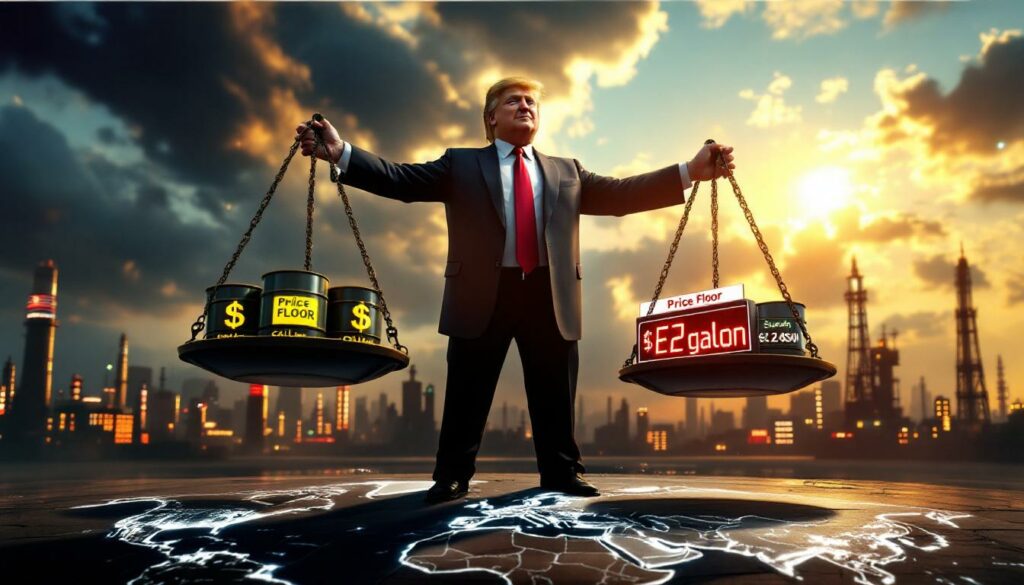Understanding Trump's Energy Policy Framework
The Trump Oil Price Range Explained
The Trump oil price doctrine represents a sophisticated economic strategy centered around keeping crude prices within a specific band that balances competing U.S. interests. This "Trump Oil Price Range" establishes both a floor and ceiling for global oil prices, creating what energy analysts consider a controlled price corridor that serves America's economic and geopolitical goals.
The floor price—historically around $40 per barrel for Brent crude—aims to ensure U.S. shale operations remain profitable and continue expanding domestic production. Meanwhile, the ceiling—approximately $75 per barrel for Brent—prevents gasoline prices from rising too high for American consumers, which could trigger economic slowdowns and political backlash.
This approach reflects a fundamental shift in U.S. energy policy, leveraging America's dual position as both a major producer and consumer to influence global markets. Unlike previous administrations that focused primarily on keeping prices low, Trump's doctrine acknowledges the importance of supporting domestic production while simultaneously protecting consumers.
Historical Context of Trump's Energy Approach
Trump's energy approach crystallized during his first administration, particularly during the 2020 oil price crisis. When Saudi Arabia initiated a production surge that threatened to bankrupt the U.S. shale industry, Trump demonstrated unprecedented willingness to apply pressure on oil-producing nations.
On April 2, 2020, Trump reportedly made a pivotal phone call to Saudi Crown Prince Mohammed bin Salman that fundamentally altered the trajectory of global oil markets. According to White House sources, Trump delivered an ultimatum: cut production to stabilize prices or face serious consequences, including potential withdrawal of U.S. military support.
As a senior legal figure in Trump's team bluntly stated: "We're not going to put up with any more crap from the Saudis." This intervention proved effective—within days, Saudi Arabia reversed course and worked with OPEC+ to implement substantial production cuts, stabilizing prices and preventing a collapse of the U.S. shale industry.
This episode established a precedent that has shaped Trump's energy doctrine: the United States would actively defend its oil price range through a combination of diplomatic pressure, legislative threats, and market influence. The approach marked a departure from previous administrations' more passive acceptance of OPEC's price-setting power.
Economic Implications of the Trump Oil Price Doctrine
Impact on U.S. Shale Industry
The doctrine's price floor creates a protective environment for U.S. shale producers, ensuring they can operate profitably while continuing to innovate and expand. With typical shale breakeven points around $35 per barrel for WTI crude at established sites, the policy's floor (around $40 Brent, which typically translates to slightly lower WTI prices) provides sufficient margin for most operations to remain viable.
This support for domestic production serves multiple strategic objectives:
- Energy security: Reducing dependence on foreign oil sources
- Job creation: Supporting employment in key energy-producing states
- Trade balance: Decreasing oil import expenditures
- Technological innovation: Encouraging continued efficiency improvements
The price band has proven particularly effective for the shale sector, which demonstrated remarkable resilience during previous price crashes. Unlike conventional oil projects that require decades-long investment horizons, shale operations can adjust production levels relatively quickly in response to price signals, making them well-suited to operate within Trump's oil price corridor.
Consumer Protection Through Price Ceilings
The upper boundary of Trump's oil price range corresponds to keeping U.S. gasoline prices at politically acceptable levels—traditionally below $2 per gallon in many states. This ceiling reflects extensive economic research showing the direct impact of oil prices on consumer spending power.
Analysis indicates that every $10 increase in crude prices results in approximately 25-30 cents higher gasoline prices per gallon, with each penny increase costing American consumers approximately $1 billion annually in lost spending power. This relationship creates a political imperative to prevent oil prices from climbing too high.
The ceiling also acknowledges the historical correlation between rising gasoline prices and economic downturns. Since 1896, only one in seven U.S. presidents has won re-election during a recession, creating strong political motivation to prevent oil-induced economic contractions.
Economic Growth Considerations
The doctrine recognizes the delicate balance between energy prices and broader economic performance. Historical data demonstrates that U.S. economic growth performs optimally when energy costs remain moderate—neither too high to burden consumers nor too low to damage domestic production.
This balanced approach represents a significant evolution in U.S. energy policy. Previous administrations often focused exclusively on keeping prices low for consumers, but this single-minded approach sometimes undermined domestic production and increased foreign energy dependence. The U.S. Economy & Tariffs shows how Trump's doctrine attempts to find the optimal middle ground that supports both consumption and production sides of the economy.
By maintaining prices within the specified range, the policy aims to create a stable, predictable energy environment that allows businesses to plan investments with greater confidence. This stability potentially supports economic growth beyond the energy sector itself.
How Does the Doctrine Affect Saudi Arabia?
Saudi Arabia's Fiscal Challenges
Saudi Arabia faces perhaps the most significant financial strain under the Trump oil price doctrine. With a fiscal breakeven price of approximately $90.90 per barrel of Brent crude in 2025, the Kingdom operates at a substantial deficit when prices remain within Trump's preferred range (typically capped around $75 for Brent).
This price gap creates a fundamental dilemma for Saudi policymakers:
- Attempt to push prices higher and risk U.S. countermeasures
- Accept lower prices and endure financial strain
- Cut production to support prices but lose market share and revenue
The fiscal breakeven price represents the oil price Saudi Arabia needs to balance its budget while maintaining social spending, military expenditures, and development projects. With actual prices averaging $15-20 below this level, the Kingdom faces difficult choices about spending priorities and financing strategies.
This situation represents a reversal from Saudi Arabia's traditional market power. In previous decades, the Kingdom could unilaterally influence prices through production adjustments. Under Trump's doctrine, this leverage has diminished significantly.
Aramco's Financial Pressures
Saudi Aramco, the Kingdom's primary revenue generator, has experienced direct financial impacts from these price constraints. The company recently reduced its quarterly dividend following a 5% year-on-year profit decline in Q1 2025. More dramatically, annual dividend projections have been slashed from $124.3 billion in 2024 to $85.4 billion for 2025—a 31.4% reduction that has significantly affected investor confidence.
This dividend reduction represents a major reversal for Aramco, which had previously presented its stable dividend as a primary selling point to international investors. The company's inability to maintain promised dividend levels has created knock-on effects:
- Declining share prices
- Increasing borrowing costs
- Eroding investor confidence
- Growing scrutiny of future financial projections
In May 2025, Aramco issued a $5 billion bond to help cover its financial commitments, with indications that additional borrowing will be necessary if oil prices remain constrained. This growing debt burden could further complicate the company's financial position over time.
Financing Dilemmas for Saudi Projects
The price constraints have severely complicated financing for Saudi Arabia's ambitious development initiatives, including Vision 2030 and showcase projects like Neom City. The latter has reportedly been scaled back from an originally planned 170-kilometer development to just 2.4 kilometers by 2030, reflecting fiscal realities under constrained oil revenues.
This downsizing exemplifies the Kingdom's broader financing challenges. With oil revenues insufficient to fund both current operations and ambitious development plans, Saudi leadership faces difficult choices:
- Scale back or delay strategic initiatives
- Increase borrowing, potentially at higher interest rates
- Sell state assets to generate immediate capital
- Reduce social spending, risking domestic unrest
The situation is further complicated by investor skepticism about asset sales. As one market analyst noted, there are "fears that proceeds will end up in vanity projects" like hosting the 2034 FIFA World Cup rather than addressing fundamental fiscal imbalances.
These financing dilemmas highlight the strategic vulnerability created by the Kingdom's continued dependence on oil revenues despite years of diversification rhetoric.
What Policy Tools Support the Trump Oil Price Doctrine?
Diplomatic Leverage
The doctrine relies heavily on diplomatic pressure, with U.S. military support serving as a significant point of leverage. According to energy policy analysts, the U.S.-Saudi relationship established in 1945 provides the foundation for this influence, with military cooperation being a particularly effective bargaining chip.
This leverage stems from the original agreement between President Roosevelt and King Abdulaziz, which established a framework of U.S. military protection in exchange for privileged access to Saudi oil. While the exact terms have evolved over decades, the fundamental arrangement remains: U.S. military support helps guarantee Saudi security in a volatile region.
Trump's administration has demonstrated willingness to explicitly link this military support to Saudi oil policy compliance. During the April 2020 crisis, for example, Trump reportedly threatened to withdraw U.S. troops from the Kingdom if production cuts were not implemented—a threat that proved immediately effective.
This approach represents a more transactional interpretation of the U.S.-Saudi relationship than previous administrations typically employed, treating military support as conditional rather than guaranteed.
Legislative Options
The "No Oil Producing and Exporting Cartels" (NOPEC) Bill represents a powerful potential enforcement mechanism for the Trump oil price doctrine. This legislation would:
- Make artificial production caps and price setting illegal under U.S. law
- Remove sovereign immunity for OPEC member states in U.S. courts
- Expose OPEC members to U.S. anti-trust litigation
- Enable freezing of assets and dollar-transaction restrictions
- Potentially force restructuring of state oil companies like Aramco
A senior U.S. source described NOPEC as a "silver bullet" held in reserve, noting that the mere threat of its implementation provides significant leverage in negotiations with Saudi Arabia and other OPEC members.
The bill's potential impact cannot be overstated. Saudi Arabia holds an estimated $1 trillion+ in U.S.-based assets that could be vulnerable to legal action if NOPEC passed. Additionally, the Kingdom's economy remains heavily dependent on dollar-denominated transactions that could be restricted under certain interpretations of the legislation.
While previous administrations kept NOPEC in reserve but never seriously pursued its passage, Trump's team has signaled greater willingness to advance the legislation if necessary to enforce the oil price doctrine.
Market Influence
The U.S. position as both a major producer and consumer of oil provides substantial market influence to complement diplomatic and legislative tools. The country's ability to adjust domestic production and strategic reserves gives it additional leverage in global oil markets.
As U.S. production has grown—reaching record levels under Trump's first term—America's market influence has expanded accordingly. This growing influence allows several market-based enforcement mechanisms:
- Strategic Petroleum Reserve releases to counter price spikes
- Encouraging domestic production increases to offset OPEC+ cuts
- Using regulatory policy to adjust U.S. production when needed
- Leveraging growing U.S. export capabilities to influence regional prices
This market power represents a historic shift. For decades, OPEC operated with minimal U.S. counterbalance. Today, U.S. production capacity serves as a significant constraint on OPEC's price-setting ability, fundamentally altering market dynamics.
Global Market Implications
OPEC+ Response Strategies
OPEC+ faces difficult choices under the Trump oil price doctrine. Production cuts to raise prices risk triggering U.S. countermeasures, while maintaining output at current levels perpetuates financial strain for many member states with high fiscal breakeven requirements.
This dilemma has created visible tensions within the organization:
- Low-cost producers (UAE, Kuwait) can operate profitably within Trump's range
- High-cost producers (Nigeria, Angola, Iran) face severe budget pressures
- Russia balances multiple strategic objectives beyond maximizing oil revenue
- Saudi Arabia bears the heaviest burden as OPEC's traditional swing producer
These divergent interests complicate OPEC+ decision-making, potentially weakening the organization's cohesion over time. Some members may increasingly question the benefits of production discipline if prices remain constrained despite their sacrifices.
This strain on OPEC+ represents a secondary benefit of Trump's oil price doctrine—beyond direct price effects, it creates strategic challenges for an organization historically opposed to U.S. energy interests.
Investment Patterns in Energy Markets
The doctrine influences global investment patterns in energy markets, potentially discouraging long-term capital expenditure in high-cost production areas while encouraging efficiency improvements and cost reduction in existing operations.
This investment shift manifests in several ways:
- Declining interest in projects requiring $80+ breakeven prices
- Capital flight from developments with decade-long payback periods
- Growing focus on short-cycle investments with flexible production profiles
- Accelerated efficiency initiatives to lower operating costs
These changes potentially accelerate technological innovation in extraction methods as producers seek to remain viable within the constrained price environment. Companies unable to adapt to the new price regime face increasing financial pressure and potential consolidation.
For energy importing nations, this investment environment potentially creates longer-term benefits through technological efficiency gains and expanded production from lower-cost resources. However, tariffs on investments could complicate this picture in certain sectors.
Geopolitical Power Dynamics
The oil price doctrine represents a significant assertion of U.S. influence in global energy markets, potentially altering traditional power dynamics between producer and consumer nations. Countries with high production costs face increased vulnerability under this framework.
This shift affects several key relationships:
- U.S.-Saudi: Increasing asymmetry as U.S. leverage grows
- Saudi-Russia: Potential for greater alignment as both face similar challenges
- OPEC-Non-OPEC: Pressure on traditional cooperation frameworks
- Producer-Consumer: Rebalancing historical interdependence
These changing dynamics extend beyond energy markets into broader geopolitical relationships. Nations that could once use oil policy as diplomatic leverage may find this tool less effective as the U.S. asserts greater control over acceptable price ranges.
For countries heavily dependent on oil revenues, this shift potentially reduces their international influence and bargaining power across multiple domains—from security arrangements to trade negotiations. The recent Alaska drilling shift represents one tangible outcome of these changing dynamics.
What Are the Financial Consequences for Oil Producers?
Debt and Financing Challenges
Oil producers operating with high fiscal breakeven requirements face increasing debt burdens when prices remain constrained. Saudi Aramco's $5 billion bond issuance in May 2025 exemplifies this trend, with indications that additional borrowing will be necessary to bridge revenue gaps.
This growing reliance on debt creates several challenges:
- Increasing interest expenses that further strain budgets
- Potential credit rating downgrades raising borrowing costs
- Debt maturity concentration risks if markets turn unfavorable
- Currency mismatch between dollar-denominated debt and local spending
For state-owned oil companies like Aramco, these financing challenges directly impact government budgets. As oil revenue declines, these entities must either reduce distributions to their government shareholders or increase borrowing to maintain expected payment levels.
This financing dilemma represents a strategic vulnerability for oil-dependent states, potentially forcing difficult policy choices across economic and social domains.
Asset Sales and Diversification Efforts
Some producers have responded by selling assets to generate capital. Aramco is reportedly considering divesting power assets and pipelines to raise funds, though questions remain about whether proceeds will support fiscal needs or be directed toward prestige projects.
These asset sales reflect both immediate financing needs and longer-term strategic recalibrations:
- Short-term: Generating capital to cover budget shortfalls
- Medium-term: Reducing operational costs and focusing on core assets
- Long-term: Attempting to diversify revenue sources beyond oil production
For Saudi Arabia specifically, the scaling back of Neom City (from 170 km to 2.4 km) highlights the tension between ambitious diversification goals and financial constraints under Trump's oil price doctrine.
Investor skepticism about these diversification efforts creates additional challenges. Market analysts have expressed concerns that proceeds from asset sales might be directed toward "vanity projects" like hosting the 2034 FIFA World Cup rather than addressing fundamental fiscal imbalances.
Investment Credibility Concerns
For publicly traded entities like Aramco, maintaining investor confidence becomes increasingly difficult when dividend expectations cannot be met. This affects both equity valuations and borrowing costs, potentially creating a negative financial spiral.
Aramco's 31.4% dividend reduction (from $124.3 billion to $85.4 billion) has significantly undermined its investment case, which was built largely on promises of stable, growing dividends. This reversal creates several challenges:
- Equity valuation pressure as yield-focused investors exit
- Reduced appetite for future equity offerings
- Higher risk premiums demanded by debt investors
- Increased scrutiny of management projections and guidance
These credibility concerns extend beyond individual companies to affect sovereign risk assessments. As state-owned enterprises struggle, rating agencies increasingly question the sustainability of national economic models heavily dependent on oil revenue.
For Saudi Arabia, this credibility challenge compounds existing economic pressures, potentially affecting everything from foreign direct investment to currency stability.
Long-Term Market Outlook Under the Doctrine
Adaptation Strategies for Producers
High-cost producers face pressure to reduce operating expenses, optimize production efficiency, and diversify revenue streams. Those unable to adapt may face increasing financial distress and potential market consolidation.
Successful adaptation strategies typically include:
- Cost optimization: Reducing per-barrel production costs
Ready to Spot the Next Major Resource Discovery?
Discover significant mineral finds as they happen with Discovery Alert's proprietary Discovery IQ model, turning complex data into actionable investment insights in real-time. Explore historic examples of exceptional returns from major discoveries by visiting Discovery Alert's dedicated discoveries page and begin your 30-day free trial today to stay ahead of the market.




